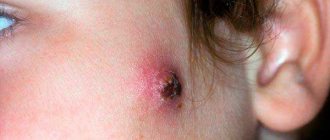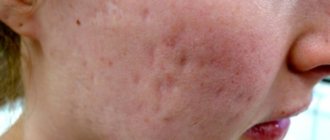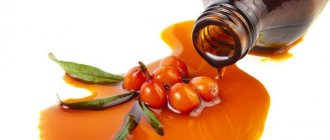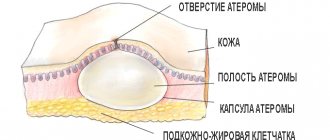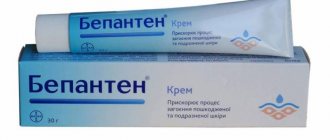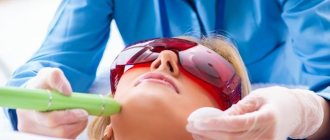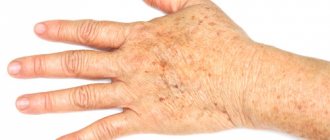Many people have encountered the problem of furunculosis. Often, after recovery, a trace of a boil remains, dark blue or brown in color, which depends on the depth of injury to the skin by a purulent infection. Compaction can be both a temporary condition and the final stage of inflammatory processes.
After rupture, the boil enters the healing stage, which may result in a scar.
Why is a boil dangerous?
A single boil, with a limited infiltration zone and small size, does not lead to serious consequences. The abscess may have a deep necrotic core. The danger lies in the outwardly inconspicuous inflammation degenerating into a deep purulent abscess of the tissues surrounding the affected follicle.
The most dangerous location of a purulent abscess: face, chin, nasal passages. The close location and direct communication of the facial sinuses with the brain increases the risk of developing severe complications. Brain damage is unpredictable; a clinical picture with the shutdown of certain zones can develop at lightning speed. In the future, this will result in memory loss, loss of vision and hearing, and death is possible.
Many patients, especially children and adolescents, do not attach much importance to the boil. It is believed that an ordinary pimple has popped up and is festering. They attempt to open it themselves, but it is not always possible to squeeze out the pus. The consequences of such actions are blood poisoning, spread of pus into surrounding tissues, phlegmonous processes, thrombophlebitis and chronically recurrent furunculosis.
Treatment of boils, furunculosis
Treatment of boils can be divided into three stages:
- at the stage of formation of the infiltrate lump, UHF and UV lamps are used, which affect the deep layers of the skin and kill the causative agent of the boil;
- when an abscess has formed, measures are taken to relieve pain, itching, inflammation with the help of Vishnevsky or ichthyol ointments;
- accelerating the process of pus release, “sucking out” is carried out with the same ointments: Vishnevsky and ichthyol;
- cleansing of the infected follicle is carried out with hydrogen peroxide, furatsilin, then antibacterial ointment is applied (for example, Levomekol);
- healing is faster with bandages with streptocide.
Eliminating single boils is fundamentally different from how to get rid of furunculosis.
In order to get rid of boils forever, an integrated approach is used, which includes:
- adjustment of diet;
- taking immunostimulating drugs;
- taking antibacterial drugs;
- careful body hygiene.
Causes of complications after a boil
Among the factors that cause the development of complications are:
- The causative agents of furunculosis (streptococci, staphylococci) are opportunistic microflora, distributed over the skin of the human body. When an abscess develops, the nearby tissue becomes infected; when such foci-boils merge, extensive purulent skin lesions are provoked.
- Secondary complications are associated with the spread of infection to the bloodstream and lymphatic system (thrombophlebitis, lymphangitis). Penetration into the lymph occurs from the lesion through primary infection of regional lymph nodes. If the pathogen penetrates the blood vessels, especially large arteries and veins, then severe pathologies develop. They are not always compatible with life (sepsis, massive abscess, pyelonephritis).
- In case of a protracted process, untimely contact with a doctor for help, or late start of therapy. With home methods: warm compresses, application of compression bandages, independent attempts to cut out and burst the pimple - it should break out on its own.
- In case of significant immunosuppressive conditions and diseases of the body - the postpartum period, after a long illness, after a course of chemotherapy in the presence of a malignant tumor, after a course of treatment with corticosteroid drugs, in case of hormonal disruption of the body, in case of AIDS and HIV infection.
Causes and external signs of the initial stage
The causative agent of purulent formation in the hair follicle of the skin is a pathogenic variety of staphylococcus. In normal conditions, there are many representatives of this type of microorganism on the surface of the skin, but only a small part of them are harmful to humans. When the level of protective properties of the skin decreases, pathogenic staphylococci begin to multiply and enter microtraumas and pores.
Dirt, sweat, excessive skin secretions, rough clothing, cuts, and abrasions contribute to weakening the protection. Finding an environment favorable for development, staphylococcus forms a nodule, which almost immediately begins active inflammatory activity. Bacteria affect the hair root, hair follicle tissue and sebaceous ducts. Externally, this process manifests itself as swelling and redness of the tissue area around the place where the hair grows. This point is considered the center of the follicle; pus and necrotic masses are most often released through it subsequently.
The first sign is a lump of a brewing boil, which begins to hurt and itch already on the second day. These signs cannot be ignored and attributed to acne or allergies. Some treatment methods, applied in time, will help reduce the likelihood of cosmetic defects, even destroying the boil before the rotting process begins.
If, nevertheless, purulent-necrotic activity intensifies, the next stage begins: development and rejection. The core of the boil finds its way out and breaks through. After the abscess has completely cleared, the healing stage begins with the formation of a scar, the size of which depends on the depth of the affected area and the size of the boil.
Furunculosis is the constant formation of many boils throughout the body, which is associated with a general weakening of the body, hormonal imbalances, and metabolic disorders. Treatment of this disease requires a systematic approach, which is prescribed by a doctor after conducting the necessary research.
Elimination of consequences
To eliminate the consequences of boils, you should seek medical help in time and do not try to open boils yourself. Traces of boils must be removed using local remedies. It is important to observe the rules of personal hygiene, normalize nutrition and rest-sleep regime, and take immunocorrective and vitamin-mineral complexes. It is possible to achieve adequate recovery of the body, which significantly helps to eliminate and prevent the consequences of the disease.
A lump under the skin or a hole
If a lump or lump appears after a boil, the cause may be poor hygiene and disinfection, or a tendency to form keloid scars at the wound site. The boil will swell if you apply pressure with antiseptic bandages, and the rest of the root of the abscess inside can thicken the subcutaneous tissue.
Often, compaction is a consequence of increased connective tissue healing, which is a normal process.
An atypical seal after a boil that does not go away can be eliminated by using ointments with a resorptive effect, anti-inflammatory liniments (Vishnevsky ointment, cinquefoil, ichthyol ointment). During healing, contractubex, boro-plus, and cosmetic procedures (dermabrasion, chemical peeling, laser resurfacing, “beauty injections,” needling) should be used to reduce compaction. Plastic surgery will help (if the defect is localized in the face and open parts of the body).
A hole, hole or external depression can remain when the pathology is deeply localized and the healing processes fail in an organism with reduced immunity. A depression is formed when there is insufficient external scarring. Corrected by visiting a cosmetologist and surgical correction of the defect. Secondary infection can complicate the situation; the hole should not bleed (additional diagnosis of the cause is required).
Edema
To eliminate swelling, liniments, gels, and sprays (ichthyol ointment, Vishnevsky ointment, bepanten) are used locally. Traditional medicine recipes for swelling are effective - aloe juice lotions and honey cakes can completely remove swelling.
Scar
The scar defect can be treated only with the use of surgical manipulations. Ointments like contractubex do not have the desired effect on already formed scar tissue. For mildly expressed defects, the skin can be polished using cosmetic procedures.
A scar that hurts is additionally “de-energized” from nerve endings, relieving the symptom of pain and constant discomfort in the patient (nerve blockade, intersection of branches of nerve endings).
Methods for removing scars include: laser resurfacing, chemical peeling, dermabrasion, and filler injections.
Description of the operation: during manipulation, scar tissue is excised and the edges are sutured, leaving a cosmetic suture, stimulating the natural healing of the wound surface (the suture should gradually dissolve). Excision of tissue close to the scar is rarely used. The scar can be removed only if the immune system is normalized. The color of the skin around the seam should be light and uniform. Prevention of wound infection with antiseptics is carried out until healing.
The boil has healed and reopened
If the boil has healed and reappeared, massive immunotherapy is performed. Such phenomena indicate severe disruptions in the body, incomplete previous removal of the necrotic rod. The rod may fall out on its own, but not completely. In this case, surface tension will heal, which should be checked by a specialist. It is better to get rid of such ulcers in a hospital setting under medical supervision.
Immunotherapy is carried out by taking a course of immunostimulant drugs (rioleukin, interferon, lycopid, octagam), autohemotherapy, membrane plasmapheresis, administration of staphylococcal vaccine and toxoids.
Other
In case of concomitant pathology, symptomatic, narrowly targeted treatment is carried out:
- Hair doesn't grow. Follicles do not form in place of scar tissue; the only way to solve the problem is hair transplantation (transplantation of your own or artificial hair).
- A boil can turn blue in the following situations: a bluish color indicates a deep lesion, which requires thorough cleaning of the necrotic core using surgery under general or local anesthesia. After excision, the skin around the lesion may turn blue and a red bruise may form, a superficial breakthrough or purple spot may open, which may indicate trauma to the surrounding tissues. Over time, it disappears on its own (it is possible to use traumeel gel, lifesaver, steamed cabbage leaf).
- If there are signs of tissue necrosis, you should immediately contact a surgeon; this indicates incomplete healing and the spread of necrosis from the remaining purulent component (point necrosis may appear at the site of the pathological process). It can only be cured by surgery.
Consequences after a boil and how to deal with them
Boils rarely go away without leaving a trace, without complications; the period of development of an abscess depends on the size of the abscess, the method of treatment, and the condition of the patient’s skin. Local exacerbations represent a cosmetic defect, while of a general nature they are associated with the spread of infection throughout the body and can threaten the patient’s life.
Ways of spread of the boil and associated complications:
- lymphogenous;
- hematogenous;
- contact.
To avoid undesirable consequences, seek help from the hospital in a timely manner, and do not self-medicate.
Are common
Common complications of a boil include:
- sepsis is a systemic inflammatory reaction of the body;
- bacteremia – blood poisoning;
- furunculosis.
Sepsis, as an exacerbation that can be fatal, is rare. The disease can be cured before complications develop: inflammation of the body, intoxication. Patients are subject to urgent hospitalization in intensive care and complex treatment.
Decreased immunity leads to the development of furunculosis, a chronic infectious disease. Several abscesses appear at once, maturing in different ways. The complication is characterized by frequent recurrences of ulcers in one place or other locations. The disease is accompanied by intoxication, pain, and severe symptoms characteristic of boils.
To cure a boil, they turn to an immunologist or surgeon for help. A course of therapy will increase the body's resistance to infection and reduce the frequency of relapses.
Local
Local complications arise due to improper treatment, late initiation of therapy, re-infection after autopsy, and abortive course of the disease.
There are exacerbations of local boils:
- seals under the skin, depressions;
- change in color of the epidermis;
- abscess formation;
- phlegmon;
- a dangerous complication is necrosis;
- hair loss;
- painful scars.
If a person has good immunity, the boil may resolve independently at the infiltration stage. This is indicated by a decrease in symptoms: signs of inflammation gradually subside, a dense infiltrate is felt under the skin, painful on palpation. The boil may turn blue, a complication due to blood stasis and a decrease in the size of the abscess.
If after a boil there is a compaction under the skin, use ointments based on tar, ichthyol or zinc, and physical procedures that promote its rapid resorption.
Boils occur in places where there is vegetation on the body. One of the complications of the disease is baldness. In the area of inflammation, the nutrition of the follicle is disrupted, purulent melting occurs, the follicles are damaged, hair falls out and cannot grow. It is possible to develop cicatricial baldness, when a scar forms at the site of the abscess, preventing the appearance of bristles.
Need advice from an experienced doctor?
Get a doctor's consultation online. Ask your question right now.
Ask a free question
After a boil, a change in skin color is observed. Hyperpigmentation is a cosmetic problem; it is not harmful to health. After an independent breakthrough, a blue or red spot remains. Its appearance is associated with pathophysiological processes with complications of inflammation. After a few months, the boil mark will go away on its own.
Surgical treatment is performed when the rod has formed: the doctor cuts the abscess, extracts the root, removes pus, and debrides the wound. Sutures are placed on the edges if the boil was removed within healthy tissue. In the postoperative period, it is important to care for the wound to minimize possible complications.
If the treated area does not heal for a long time, a hard, hypertrophied keloid scar may form. To remove traces of boils, operations are performed to remove scar tissue and apply a cosmetic suture.
When the boil bursts, a purulent core is released from it. After it comes out, a hole remains in place of the pustule. The hole will close with a crust and heal; if the area of the hole is large, a scar may form. The complication does not threaten to deteriorate the body’s condition and affects the appearance of the affected area.
Dangerous consequences of a boil are abscess, carbuncle, phlegmon, necrosis:
- An abscess is accompanied by the accumulation of pus between the tissues with the formation of a pyogenic membrane.
- Carbuncle is a complication that is characterized by simultaneous inflammation of several hair follicles that are prone to fusion.
- The formation of phlegmon indicates the penetration of infection from the boil deeper into the subcutaneous fat. Connective tissues undergo purulent melting. The process is not limited to the capsule; it is difficult to stop its spread.
Complications are considered serious diseases and require hospitalization and treatment in a surgical department.
Remote
Long-term exacerbations of an abscess include:
- lymphadenitis as a consequence of a boil;
- meningitis;
- lymphangitis;
- kidney diseases;
- complication in the form of phlebitis and thrombophlebitis.
An infection from an abscess can penetrate the lymphatic and circulatory system. The spread of infection leads to inflammation of the nodes - lymphadenitis. They increase in size and cause pain on palpation. Visually identified as a tumor.
If the boil affects the lymphatic vessels, lymphangitis develops: red painful stripes, burning, and itching appear at the points of contact between the vessels and the skin. The disease is eliminated with antibiotic therapy.
Meningitis or inflammation of the meninges develops when a boil in the face is complicated. Infection from a purulent focus can easily penetrate arteries and veins. Formations on the head pose a great danger: to avoid problems, patients with boils in this area are hospitalized for treatment in a hospital and receive complex therapy.
Phlebitis and thrombophlebitis are inflammation and blockage of the lumen of the veins caused by the spread of infection through the vessels of the circulatory system. It is forbidden to squeeze out abscesses: if you try to remove the rod on your own, the infected elements can be carried by the bloodstream and cause a complication - thrombosis.
Infection that provokes the appearance of boils can penetrate the internal organs.
Some microorganisms have antigens similar to the Rh factor of cells, which leads to autoimmune diseases. These mechanisms often provoke kidney damage.
If the boil has healed and opened again
When ulcers recur in one place after short intervals, complications are diagnosed for the presence of furunculosis. Increasing the body's defense mechanisms and taking antibiotics will help remove recurrent abscesses. Treatment of boils is carried out according to the standard scheme, depending on the stage of the disease.
A lump after a boil may fester again after healing is complete due to decreased immunity. This complication is observed with hypothermia, vitamin deficiency, constant stress, and exacerbation of chronic infection.
What happens if you don’t cut out the boil?
If the boil is not opened, serious complications may occur. An abscess at the purulent-necrotic stage contains pus, which provokes the development of intoxication. If the element is not able to break through on its own, the infected substances from the edema will go into the blood vessels and tissues located deeper. The process can become systemic, accompanied by severe intoxication.
There is a high risk of complications from ulcers in the face area - the chin area, nasolabial triangle. If the disease is advanced and therapeutic methods for eliminating the boil are not carried out, death is possible.
The article has been reviewed by the site editors
What happens if you don’t cut out the boil?
With the development of a purulent process, multiple ulcers and the failure of conservative treatment alone, surgery is necessary. In situations where the patient refuses to remove the abscess, the following reactions may develop:
- Local. Massive suppuration develops in the form of a carbuncle (suppuration of a group of hair follicles), an abscess (deep lesion with purulent melting of the surrounding tissue with the formation of a cavity). A fistula is formed - an atypical “hole” through which pus flows out, erysipelas (swelling of the tissue with the phenomenon of hyperemia and hyperthermia), phlegmon (a purulent-inflammatory process that does not have clear boundaries, “creeping” in the subcutaneous tissue). Long-term reactions due to inflammation of lymphatic vessels and veins (thrombophlebitis, lymphangitis, lymphadenitis).
- General damage to the body. Distribution of ulcers without limitation to one zone (ear, nose, buttock), covering several at once. There are furunculosis (ulcers can ripen multiple times) and sepsis (spread of pus through the bloodstream and new formation of boils in any place of the body).
Traces of boils can be removed at home; if you have a question about how to remove a scar, consult a doctor. Together you can choose a way to eliminate scars, prevent the recurrence of boils and swelling of the affected areas.
The development of a boil depends on many factors. Here you can note the place of occurrence, correct treatment, timely consultation with a doctor, skin characteristics, etc.
The consequences can also be very different, ranging from the transition of the disease from an acute form to a chronic one, and ending with the appearance of scars on the skin after treatment. Scars after boils
Most often they are not too noticeable on the skin; traces appear only in the cold or after sunbathing. Why do marks remain after abscesses and how can you get rid of them?
How to quickly remove scars after boils
For many people who have experienced boils, removing the scars left after treatment is a major concern.
Naturally, this issue worries women most of all, because they should look attractive and ideal in almost any situation.
At the moment, there are many different methods of combating both furunculosis itself and its consequences. Traditionally, all methods are divided into several main categories: traditional recipes, drug treatment and removal of scars using procedures.
How to remove scars from boils using folk remedies
Most often, people use lemon juice to remove scars. This method is good because it is extremely simple - just squeeze the juice from a lemon and wipe it on the affected area of the skin. After some time, with regular procedures, the scar will become less noticeable, although it will not completely disappear.
Another effective remedy to combat this problem is sage tincture. To prepare it, add a tablespoon of boiling water to a glass of boiling water and leave for about half an hour in a warm place. Once ready, you need to strain the tincture and add half a teaspoon of honey and mix it all thoroughly.
After this, the infusion can be considered ready and can now be used for lotions, which must be done 3 times a day. In addition, you can also use a vinegar solution. To prepare it, you need to dilute the vinegar with water in a ratio of 1 to 3.
For fresh scars, you should use a frozen solution, but for old ones, it is better to soak a bandage in it and apply it to the affected area for 5 minutes. The procedure must be performed every two days until the scar from the boil is completely removed.
Drug treatment of scars after boils
Despite the abundance of various gels, ointments and creams for scars and scars on the market recently, at the moment the following drugs are the most popular and effective:
Kontraktubeks ointment has anti-inflammatory, healing and fibrinolytic (absorbable) effects. Its use is recommended both for fresh scars and scars, as well as for old ones. It is worth noting that in order to achieve a positive and visible effect, the ointment should be used 2-3 times a day for at least 3 months.
Gel "Dermatix" - softens the skin on the affected area and also destroys keloid scars. Immediately after application, the gel dries quickly and only a film invisible to the naked eye remains on the skin.
Scars under the influence of this drug begin to fade and gradually resolve. The course of treatment involves applying the gel at least 2 times a day for at least two months.
Boil scar removal procedures
The fastest and most effective way to remove a boil scar is to carry out specialized cosmetic procedures. Today, there are several procedural methods used to solve this problem: laser resurfacing, chemical peeling, and hardware cosmetology.
Each of these procedures has its own characteristics, so the decision about which one to choose should be made by a specialist after preliminary consultation and examination. Despite the fact that all of them are extremely effective and allow you to get rid of scars as quickly as possible, they are not recommended earlier than 3 months after removal of the boil.
Author: Tatiana Velikaya
Zinc acne ointment
Next entry >> How to make a bio henna tattoo at home (photo)
Why do marks remain after boils?
It is impossible to avoid the appearance of scars from boils
only if they were located in the groin area and armpits. On all other parts of the body, including on the face, in the complex area of the nasolabial triangle, on the forehead and on the cheeks, even mild marks of inflammation can be avoided.
The first and most important reason why ulcers leave marks is improper treatment, including self-medication with traditional methods. In this case, in order to avoid such unpleasant consequences, you need to consult a doctor when the first symptoms of a boil appear, a painful compaction appears in the thickness of the skin. Timely contact with a specialist will help:
- accelerate the course of the disease;
- prevent complications;
- ensure proper opening and cleansing of the wound from pus and the core;
- speed up healing;
- avoid the formation of postoperative scars and scars.
Every patient should understand that doctors are the right solution to health problems. No one can completely eliminate the occurrence of scars after a boil. But you need to try to avoid it, so it’s important to go to the doctor on time.
Scars from boils - what to do and how to get rid of them
Boils, after healing, leave an unpleasant reminder of themselves in the form of scars. It is quite obvious that such a cosmetic defect causes enormous discomfort, especially with scars from boils on the face. In this material we will give tips and recommendations on how to get rid of boil scars in the best possible way as quickly as possible.
How do boil scars form?
Any boil, regardless of what part of the body it forms on, goes through several stages. From a small pimple, it develops into a fairly large swelling with a dense infiltrate, which, if not treated in a timely manner, can reach very large sizes. After this, suppuration and softening begin in the central part and a core appears, which, over time, comes out.
After the boil matures, an ulcer remains on the skin, the healing process of which lasts several days. As a result, a scar is formed at the site of the former boil, which is atrophic in nature and, if no action is taken, it may remain forever.
It should be immediately noted that there is no effective remedy that would prevent the very formation of ulcers and scars after boils, but you can get rid of them quite successfully after the healing process.
How to get rid
In order to remove scars from boils, you can perform a number of procedures at home, or you can contact a beauty salon that offers similar services.
READ ALSO: Types of rashes in children - Rashes (rashes)
How to get rid of scars from boils
Removal of scars from boils in a salon is carried out using modern cosmetology equipment using one of the following methods.
- laser resurfacing;
- chemical peeling;
- dermabrasion;
- needling;
- pruning;
- composter cutting;
- filler injections.
Let's look at each of the methods in more detail.
Laser resurfacing allows you to effectively get rid of a scar after a boil, regardless of its shape - convex or depressed.
Using special equipment, a laser is applied to the skin, as a result of which the upper layer of scar formation evaporates and a small wound with absolutely smooth edges is obtained, which heals quickly and no traces remain in the place of the former boil.
The second option is to burn microscopic holes using a laser, which trigger the process of tissue regeneration at the site of the scar. This method is called photothermolysis.
Removing a scar after a boil
Removing a scar after a boil using chemical peeling involves applying a special solution to the skin. As a result of its influence, necrosis of the upper layer occurs and the process of cell renewal begins and, as a result, the trace of the boil disappears.
Dermabrasion is a fairly simple procedure in which the top layer of skin at the site of the scar is scraped off and a new layer of tissue is formed. It is necessary to perform dermabrasion exclusively with special tools, so as not to get an even more negative effect than before.
During needling, many punctures are made at the location of the boil scar, thereby causing the process of skin regeneration and removal of the boil scar. This method is similar to photothermolysis, but differs from it in the instrument used.
READ ALSO: Signs of diabetes in children: the first symptoms, how they appear in a child
Trimming and cutting techniques are essentially micro-operations. In the first case, using a special tool, the tissue fibers that hold the base of the boil scar are destroyed, and in the second case, the boil scar is simply cut out.
Injections are used to remove those scars that have a depressed shape. Special preparations called fillers, or simply fillers, make the skin lift and even out.
It should be noted that doctors recommend removing the scar from a boil only three months after its treatment.
A boil scar on the face should only be removed by a highly qualified specialist.
How to avoid a scar after a boil
It is quite difficult to remove a scar after a boil. Therefore, it is much easier to prevent its formation. To do this, it is necessary to treat the boil in a timely manner, for which, immediately after its appearance, consult a doctor.
How to avoid a scar after a boil
When healing the wound left after a boil, use special compresses with Vishnevsky ointment or ichthyol.
Also, in order to avoid leaving a scar from a boil, you can use Levomikol ointment, which contains an antibiotic and allows the wound to heal as quickly as possible and without cosmetic problems.
READ ALSO: Rash on the elbows of a child: photos of acne with explanations of the causes of the rash, why are there pimples on the knees?
prevent scar formation due to boils
It is most difficult to prevent the formation of a scar with boils in the groin and armpit area, but in all other cases, including boils on the face, it is quite possible to avoid scars.
News MirTesen
Is it possible to remove existing scars?
Unfortunately, improper treatment of a boil can damage the upper layers of the dermis so much that it will be almost impossible to remove the spots after the abscess. Only cosmetic intervention will help here - these are injections to smooth out scars, skin resurfacing, procedures to lighten the upper layers of the dermis, and so on. All this will allow you to restore its former beauty. It is very important not to overdo it. Remember that most spots and scars lighten over time, and therefore, in the first six months, darkening in the area of the former wound is normal and does not require treatment.
The laser spot whitening method also has a good effect on scars after boils, but before you try this procedure, you should consult your doctor.
Many people have encountered the problem of furunculosis. Often, after recovery, a trace of a boil remains, dark blue or brown in color, which depends on the depth of injury to the skin by a purulent infection. Compaction can be both a temporary condition and the final stage of inflammatory processes.
After rupture, the boil enters the healing stage, which may result in a scar.
Causes of marks after healing of the abscess
The seal after the boil remains only in cases where the abscess was squeezed out at home. An abscess opened in a medical institution always heals without a trace, since with proper treatment of the wound its contents are completely removed.
A seal after a boil may remain for the following reasons:
- when opening the abscess, its core was not removed;
- when squeezing out the boil, not all the pus came out;
- the abscess opened on its own and was re-infected.
Each boil has a dense purulent core. As the abscess matures, this core gradually comes out, and as a result, over time, the abscess opens on its own. With self-squeezing, the pus can be completely removed, but the core of the boil remains in the wound. Over time, the wound heals, but the remaining rod cannot come out, so when palpated, it feels like a compaction on the skin.
When an abscess is squeezed out at home, the pus may not be completely removed. A seal after a boil is formed for the same reason as with incomplete removal of the rod.
Causes of marks from boils
Compaction after a boil occurs for several reasons:
- When removing the abscess, the necessary principles of hygiene were not followed. The wound might not have been disinfected. In such a situation, the infection ended up in the wound and caused a lump.
- The shaft of the boil was not completely squeezed out. A piece of the rod remained in the wound; the infection was not completely eliminated, so the pathogen continues to reproduce, and a new one forms in place of the old boil.
However, no matter how the boil was removed, a lump will still form after it.
The abscess will be completely eliminated, and the symptoms of furunculosis will no longer bother the patient. A compaction forms due to the growth of connective tissues, which begin to tighten the wound. After removing the abscess, it is important to maintain personal hygiene rules to prevent the disease from re-developing, since furunculosis can develop into a chronic form.
What to do for prevention?
To avoid leaving a lump after removing the boil, doctors recommend following simple rules. The first and main thing is to ensure that after removing the abscess, all pus is removed from the wound. For such purposes, they resort to gauze bandages that are soaked in Vishnevsky ointment. Sometimes Levomekol is used, which has a healing effect. It is important to prevent hypothermia and overheating, especially in a child. It would be useful to follow a healthy diet and take vitamin and mineral complexes, which will allow the wound to heal faster and have a beneficial effect on the body.
Can a lump go away on its own?
Often, swelling after a boil goes away on its own and does not require additional treatment. After removal of chiria, a compaction always forms, as the integrity of the skin is compromised. Even in situations where the boil was removed according to all the rules, the lump will last for about several days, since the wound from the abscess is located quite deep under the skin. If the removal was carried out by a specialist, then the chances that the compaction will go away on its own are much greater. If the patient self-medicated, there is a high probability that the swelling after the boil will remain. That is why, if you suspect furunculosis, it is important to promptly contact a specialist who will prescribe the required treatment and can professionally eliminate the abscess. Otherwise, you will have to get rid of the seal using certain pharmaceutical products or cosmetic procedures.
Algorithm for opening a boil
The procedure is carried out under local anesthesia, therefore, without any pain. The doctor treats the formation and the skin around it. A lot of cotton pads and alcohol are prepared in advance - in this case, disinfection plays a big role.
Using a sterile scalpel, an incision is made and all pus is removed. Along with the pus, the rods (the roots of the boil) also come out; it is important to remove all of them. Usually, when the formation is mature, the roots are easily removed by applying light pressure. The wound is cleaned as thoroughly as possible, after which drainage (a special rubber strip) is installed. After drainage is installed, the wound is covered with a sterile dressing with hypertonic saline solution or antibacterial ointments.
If after the autopsy the boils continue to appear:
- the doctor prescribes a blood test to check for the presence of diabetes mellitus - purulent inflammation on the skin is often an indicator of the presence of this disease;
- drug therapy is being reviewed;
- a special diet is prescribed.
After removing the abscess, complete healing will take from 10 to 30 days, depending on its size. During this period, it is important to follow all the doctor’s recommendations and prescriptions, since if an infection gets into the wound, serious complications can develop.
This kind of removal leaves a small scar, but, you see, scars on the face do not decorate a person. It is for this reason that doctors began to use a laser method for removing boils. Laser removal can be carried out even when the boil is not yet fully mature. There is no need to use any ointments after the laser procedure, and the procedure does not leave any scars. The healing process is quick and painless.
Sometimes spontaneous opening of the boil is observed. In this case, you need to thoroughly wash and sanitize your hands; if you have sterile gloves, put them on. Take cotton or gauze sponges and alcohol. Using gentle pressure, clean the wound from pus - it is important to make sure that the rod comes out along with the pus. Afterwards you need to treat the wound and cover it with a sterile bandage. You definitely need to see a doctor. The surgeon will debride the wound and install drainage. It is important to understand that without proper medical care, the abscess will form again and grow.
How to remove the seal?
Treatment of seals after boils is carried out using the following methods:
- ethnoscience;
- use of medications (mainly ointments);
- cosmetic procedures in beauty salons;
- plastic surgery.
You can eliminate the consequences of boils on the skin using “homemade” recipes, the main thing is to start therapy on time.
How to get rid of compaction using folk remedies?
Traditional healers recommend using lemon juice to get rid of lumps after a boil in children and adults. Use freshly squeezed liquid to wipe marks every day. It is also recommended to make a semi-alcoholic warming compress. Apply it to the seal site for an hour. Before going to bed, the affected area should be lubricated with iodine, however, only if there are no allergic reactions to this drug. Vinegar also helps get rid of scars from boils. To make a compress, you will need to take 1 part vinegar and 3 parts water, soak gauze in the resulting liquid and apply it to the bump. You can also remove scars from boils using sage. To prepare the tincture, take 1 tablespoon of dried sage and add a glass of hot water. The liquid is infused for 2 hours, after which it is filtered. Add half a tablespoon of honey to the finished tincture.
Drug treatment
Treatment for getting rid of seals also involves the use of medications. Often, experts prescribe the use of ointments that need to be rubbed into the affected skin 3 times a day. The most common products are Contractubex and Dermatix. Therapy lasts several months. It is important to remember that when thickening after boils, the correct treatment, drug and dosage is prescribed only by the doctor, based on the individual characteristics of the individual patient.
Boils are large and painful “pimples”, the seriousness of which people often underestimate. Out of old habit, trying to squeeze out a boil, a person not only does not cure the problem, but also greatly aggravates it.
How to eliminate spots after subcutaneous boils?
Having surfed the Internet, it is possible to find a large number of articles devoted to how to eliminate subcutaneous boils at home and using various procedures, but it is almost impossible to find an article that would tell you how to get rid of the consequences after subcutaneous boils or, even better, how to avoid this defect. spots of subcutaneous boils.
There are two main reasons that can cause spots on the skin of the face. The first reason is that this situation was missed at the initial stage; the necessary disinfection of subcutaneous boils and treatment were not carried out. The second reason is an independent attempt to squeeze out a subcutaneous boil. From this we conclude that in order to prevent the occurrence of spots, it is necessary not to squeeze out subcutaneous boils, not to refuse treatment and be sure to monitor facial skin hygiene.
Remedies that will cure spots on the skin of the face after subcutaneous boils
A mask using green clay and rosemary oil. We will need twenty-five grams of clay and three or four drops of oil, a little cold purified water. When stirring, a homogeneous mushy mass should form. When the mixture is ready, it should be applied to areas of the skin with problems for ten to fifteen minutes.
How to choose perfume?
Summer skin care
Stains from subcutaneous boils can be removed using a bleach mixture. For it you will need one protein, fifty grams of lemon juice. Mix the ingredients until smooth and apply to the skin for fifteen minutes. You can also use the following mixture: add fifty grams of lemon juice and a little water to twenty-five grams of white clay. Mix all ingredients until smooth. Apply the resulting mixture to the problem areas and do not touch for fifteen minutes.
For the bleaching mixture you will need fifty grams of tomato pulp and twenty-five grams of starch. Apply the resulting mass for fifteen minutes. It is also possible to apply cucumber to areas with problems or wipe your face with cucumber juice.
A good assistant in the fight against blemishes is tea tree oil, which perfectly whitens the skin of the face and will help get rid of the problem.
To get rid of stains, you can use mint, lavender, and rosemary oils.
For problem skin, you need to use cosmetic paraffin, which can be found in a pharmacy. It needs to be melted in a small bowl and applied with a stick exactly to the areas where there are problems. If you have a network of blood vessels on your face, then it is better not to use paraffin.
A very good cinnamon and honey mask. You need to mix twenty-five grams of honey with one spoon of cinnamon powder and spread on problem areas for twenty to twenty-five minutes. It is recommended to use this mask every other day.
How to recognize a boil and what to do?
It begins with a large lump swelling on the skin. As a rule, it itches and causes pain when you touch it.
As soon as these signs appear, the best thing to do is consult a dermatologist. Often, people neglect to visit the doctor because of a “ pimple.”
" This indicates a person’s ignorance of the threats that a boil poses.
The trouble is that the bacteria that provoke its appearance live on the skin constantly. They lead to negative consequences only if the protective functions of the epidermis are reduced or the hormonal levels of the body are disrupted. It turns out that one boil can also wake up nearby bacteria. In addition, the pus that forms inside the lump can penetrate the skin and enter the blood.
Naturally, circulating through the blood, staphylococcus will find other weak spots on the body, and more and more boils will begin to appear. This leads to the development of a disease such as furunculosis. It is much more difficult to treat. An integrated approach is required; getting rid of a sore is difficult, and its consequences are even more difficult.
Therefore, when the first symptoms appear, it is better to consult a doctor. If this is not possible, measures must be taken to treat the problem.
Treatment of boils
Staphylococcus not only grows, it softens the cells of the epidermis, as if turning them into pus. Therefore, the longer it grows and develops, the more cells it will damage. The consequence of this, even if furunculosis does not develop, will be a very unpleasant event - a strong, deep scar will appear. What remains is deformed skin, dark in color. Such scars most often do not go away on their own.
To avoid their appearance, and this is the best treatment, it is necessary to take a number of measures already at the initial stage of development of the sore.
Proper treatment will eliminate the appearance of a scar:
- As soon as a lump appears, it is necessary to treat it with ointment, which will facilitate the rapid release of pus to the outside. It is necessary to speed up the process of maturation of the rod. Vishnevsky ointment is suitable for this. It is applied in a thick layer, and the site of inflammation is covered with a sterile bandage. Under its influence, the pus comes out faster.
- When the pus is released, a hole remains (if the pus does not come out for a long time, it is better to consult a doctor and get rid of the contents of the lump surgically). It is treated with an antiseptic, or better yet, with a drug containing an antibiotic. You can rinse with hydrogen peroxide and then apply Levomekol or Levomycetin (solution). This way the wound will heal faster.
- You don’t have to spend money on a large number of ointments, but get by with one Vishnevsky ointment. It also heals wounds well. For several days you need to treat the boil site with this ointment until the dermis is restored.
Treatment of scars and scars left from boils
If a mark still remains, due to improper treatment, or due to a large area of skin damage, you no longer have to fight staphylococcus, but with scars. This is also a rather difficult process, since the dermis is severely injured. A crust forms on top of the void left by the pus, which peels off over time. Underneath, the skin acquires an unpleasant dark color and naturally has an uneven structure.
You can use emollient ointments to help treat scars. They will make the skin more even and smooth. This process is quite long, but it helps to get rid of the problem.
Among these ointments:
Folk remedies
Of course, traditional medicine also reveals to us dozens of recipes for the treatment of scars. Since one of the main problems is darkening of the skin at the site where the boil was, whitening products are recommended.
Among them:
- Lemon juice;
- Celandine;
- Aloe;
- Hydrogen peroxide;
- All kinds of essential oils;
- Cucumber juice;
- Kefir masks.
It is important to remember that treatment with such aggressive methods as lemon juice requires additional care. The skin needs to be softened and moisturized afterwards. Or dilute the juice with honey, chamomile decoction or any other sedative. Moisturizing creams afterward are an extremely necessary measure, since dry dermis will peel off and the scar will take on an even more unsightly appearance.
Cosmetology procedures
A good cosmetologist can also help get rid of scars. Hardware cosmetology quickly removes skin unevenness and evens out its color.
Laser resurfacing can be used to eliminate scars. Old scars are not removed in one go; several visits to the doctor's office (or cosmetologist) will be required; fresh and small ones can be removed at a time. Treatment is carried out under local anesthesia. Afterwards, the skin is treated with special anti-inflammatory drugs and requires careful care. The treated dermis should not be exposed to sunlight, visiting a bathhouse is prohibited, and cosmetics containing alcohol should not be used. However, you need to moisturize your skin and nourish it.
For multiple boils and, accordingly, a large number of scars, the treatment is slightly different - CO2 laser resurfacing. This procedure is also done under slight anesthesia (the skin is treated with a special lotion containing painkillers).
Before starting the procedure, the dermis is cleaned, anesthetized, the eyes are protected with special glasses, and the specialist begins the grinding process. To put it quite simply, the top layer of the epidermis is burned. Small scars, scars, defects disappear. Remains " new
» a smooth layer of the epidermis that has a healthy color and smooth texture. However, not immediately.
After a burn, the skin looks very painful. It requires long-term care with special products after the procedure and brings a lot of discomfort. Therefore, before agreeing to this type of treatment, you need to weigh all the risks, make sure that in a particular case the procedure will help, and only then agree to carry it out.
A less traumatic procedure offered by cosmetologists is chemical peeling. This procedure is based on the use of fruit acids.
There are three types of procedure:
- Deep peeling;
- Average;
- Surface.
The choice of the required option, of course, cannot be done independently. This is determined by a specialist based on the clinical picture of the condition of the dermis. From " age
» Scars, their size and depth depend on the choice of acids.
The procedure has its contraindications, and also requires specific care after the procedure. Therefore, everything is done strictly according to the recommendations of cosmetologists and under their supervision.
Getting rid of scars after boils is quite difficult. The procedures are painful and expensive, traditional methods help very slowly, and ointments may not have the desired result. Therefore, it is best to take action immediately at the first sign of a problem. If the bumps are very large or painful, it is best to see a dermatologist and have the boil lanced at the doctor's office.
Professionally and using appropriate medications. This will reduce the risk of difficult-to-remove scars. Treatment for boils is long and painful, but removing scars is even more difficult.
A boil is a large focus of suppuration caused by anaerobic bacteria (staphylococcal infection). Such ulcers are located deep under the skin and take a long time to mature. Inflammations can hurt, so to quickly get rid of the problem, surgical opening of the boil is practiced.
Medicinal methods are often used to treat boils. They involve treating the abscess with special ointments. At each stage of development of the abscess, different drugs are used. First, use ointments that accelerate the maturation of the boil. The use of such drugs allows you to accelerate the formation of a purulent core and push the contents of the abscess cavity closer to the surface of the skin.
Then emollient ointments are used to facilitate the process of opening the boil on your own. When the purulent contents begin to come out, a deep wound is formed, for the treatment of which antiseptics are used. Along with antiseptics, it is necessary to additionally use antibacterial drugs to avoid infection of healthy skin. Wound healing medications are also used.
Sometimes it becomes necessary to open the boil. Often patients are faced with the fact that the abscess does not mature for a long time. The purulent contents remain deep under the skin and cannot come out, which is accompanied by a number of unpleasant symptoms - fever, pain in the area of suppuration, discomfort when touched.
If it is necessary to speed up the healing process, you should contact a surgeon who will perform an opening procedure and remove the purulent contents of the inflamed cavity. You cannot open a boil at home.
Opening an abscess
Only a doctor should open a boil. Treatment is carried out in the surgical room. The whole procedure does not take much time, but requires the right approach. Due to the deep location of the suppuration, surgical opening is performed under local anesthesia.
The doctor treats the skin with an anesthetic and an antiseptic solution. A small incision is then made using a scalpel. Using a special instrument, the surgeon removes the hard purulent core and then clears the cavity of any remaining contents. A large wound is formed at the site of the boil, which is then treated with an antiseptic solution and covered with a bandage.
The bandage must be changed several times a day. Ointments are applied directly into the resulting cavity to prevent infection of the wound and accelerate tissue regeneration. For this purpose, the doctor can use tetracycline or hydrocortisone ointment; Levomekol is used to treat small wounds.
The wound is filled with ointment and covered with a bandage on top. The next time you change the dressing, the wound must be cleaned of any remaining ointment and re-treated with the drug.
You should consult a doctor for advice on how to open a boil in the following cases:
- if the size of the abscess exceeds 10 mm in diameter;
- if the boil is inflamed, but the purulent contents do not come out;
- when the abscess re-forms;
- in case of severe pain in the area of suppuration and fever.
You should also consult a surgeon if the boil bursts on its own, but after a while suppuration develops in the same place.
How to get rid of scars from boils
Boils, after healing, leave an unpleasant reminder of themselves in the form of scars. It is quite obvious that such a cosmetic defect causes enormous discomfort, especially with scars from boils on the face. In this material we will give tips and recommendations on how to get rid of boil scars in the best possible way as quickly as possible.
How do boil scars form?
Any boil, regardless of what part of the body it forms on, goes through several stages. From a small pimple, it develops into a fairly large swelling with a dense infiltrate, which, if not treated in a timely manner, can reach very large sizes. After this, suppuration and softening begin in the central part and a core appears, which, over time, comes out.
How do boil scars form?
After the boil matures, an ulcer remains on the skin, the healing process of which lasts several days. As a result, a scar is formed at the site of the former boil, which is atrophic in nature and, if no action is taken, it may remain forever.
It should be immediately noted that there is no effective remedy that would prevent the very formation of ulcers and scars after boils, but you can get rid of them quite successfully after the healing process.
How to get rid
In order to remove scars from boils, you can perform a number of procedures at home, or you can contact a beauty salon that offers similar services.
How to get rid of scars from boils
Removal of scars from boils in a salon is carried out using modern cosmetology equipment using one of the following methods.
These include:
- laser resurfacing;
- chemical peeling;
- dermabrasion;
- needling;
- pruning;
- composter cutting;
- filler injections.
Let's look at each of the methods in more detail.
Laser resurfacing allows you to effectively get rid of a scar after a boil, regardless of its shape - convex or depressed.
Laser resurfacing removal of a boil
Using special equipment, the skin is exposed to a laser, as a result of which the upper layer of scar formation evaporates and a small wound with absolutely smooth edges is obtained, which quickly heals and no traces remain in the place of the former boil.
The second option is to burn microscopic holes using a laser, which trigger the process of tissue regeneration at the site of the scar. This method is called photothermolysis.
Removing a scar after a boil
Removing a scar after a boil using chemical peeling involves applying a special solution to the skin. As a result of its influence, necrosis of the upper layer occurs and the process of cell renewal begins and, as a result, the trace of the boil disappears.
Dermabrasion is a fairly simple procedure in which the top layer of skin at the site of the scar is scraped off and a new layer of tissue is formed. It is necessary to perform dermabrasion exclusively with special tools, so as not to get an even more negative effect than before.
During needling, many punctures are made at the location of the boil scar, thereby causing the process of skin regeneration and removal of the boil scar. This method is similar to photothermolysis, but differs from it in the instrument used.
Trimming and cutting techniques are essentially micro-operations. In the first case, using a special tool, the tissue fibers that hold the base of the boil scar are destroyed, and in the second case, the boil scar is simply cut out.
Injections are used to remove those scars that have a depressed shape. Special preparations called fillers, or simply fillers, make the skin lift and even out.
It should be noted that doctors recommend removing the scar from a boil only three months after its treatment.
A boil scar on the face should only be removed by a highly qualified specialist.
How to avoid a scar after a boil
It is quite difficult to remove a scar after a boil. Therefore, it is much easier to prevent its formation. To do this, it is necessary to treat the boil in a timely manner, for which, immediately after its appearance, consult a doctor.
How to avoid a scar after a boil
When healing the wound left after a boil, use special compresses with Vishnevsky ointment or ichthyol.
Also, in order to avoid leaving a scar from a boil, you can use Levomikol ointment, which contains an antibiotic and allows the wound to heal as quickly as possible and without cosmetic problems.
prevent scar formation due to boils
It is most difficult to prevent the formation of a scar with boils in the groin and armpit area, but in all other cases, including boils on the face, it is quite possible to avoid scars.
We recommend reading
How to quickly cure a boil on a finger
Aloe for boils
Treatment of a boil under the armpit
Symptoms of pyoderma and treatment in adults and children
Treatment at home
Opening a boil at home is strictly prohibited.
It is impossible to clean the wound on your own after opening the abscess; this can only be done with the help of special tools.
An incorrectly opened boil will, at best, become inflamed again, and in the worst case, sepsis may develop, as a result of which the infection will spread throughout the body.
Treatment of boils at home is carried out using special ointments. Which drug should be used depends on the stage of development of the abscess.
When a slight inflammation has just appeared on the skin, ointments are used that accelerate the maturation of ulcers. For this purpose, ichthyol ointment is often prescribed. The drug draws pus out and at the same time softens the tissue, facilitating easy opening of the abscess. The medicine is applied to a gauze bandage, which is then applied to the boil. The dressing is changed 3-4 times a day.
When the purulent contents are clearly visible under the skin and a fully formed core of the abscess is visible, ichthyol ointment is replaced with Levomekol. This drug has a pronounced antibacterial effect and is effective against anaerobic microorganisms, including Staphylococcus aureus, which provoke the appearance of boils. Levomekol is also applied to a bandage that is applied to the inflamed abscess.
A few days after the boil has matured, it opens. The boil usually opens 3-5 days after the start of using ointments that accelerate the maturation of the abscess. The purulent contents come out and must be carefully removed. To do this, soak a cotton pad in any antiseptic solution and thoroughly wipe the wound and the skin around it.
To avoid infection, it is necessary to use antibacterial ointments. After opening the abscess, treatment can be continued, since the presence of pus in the wound does not reduce the effectiveness of this drug. Treatment of the wound continues even when all the pus is drained and the wound is clean. In this case, it is important to ensure that the shaft of the boil also comes out. If this does not happen, you cannot remove it yourself; you must visit a surgeon.
If the rod comes out, treatment is continued using wound healing drugs. To do this, you can continue to use Levomekol, since it contains a component that accelerates tissue regeneration, or Vishnevsky ointment. The selected ointment is applied to the wound in a thick layer and covered with a bandage on top. The dressing should be changed three times a day.
If, despite the use of ointments, the abscess does not open for a long time, you should consult a doctor.
What are boils and carbuncles?
The main rule in treating a carbuncle at home is to avoid damaging or irritating it, because this can lead to the formation of a deep scar and the spread of infection deep into the skin or to healthy areas.
To reduce pain and speed up the maturation, opening and healing of the carbuncle, you need to apply warm compresses. Heat increases blood flow to the abscess, which means more infection-fighting white blood cells are sent to it. The carbuncle matures faster, the pus comes out and the wound cleanses and begins to heal.
To reduce the risk of spreading infection, the following steps should be followed when applying a compress:
- Wash your hands thoroughly with soap, preferably antibacterial.
- Gently rinse the carbuncle with warm water.
- Place a clean cloth on it, soaked in warm water and lightly wrung out. Leave for 15–20 minutes. You can use a heating pad instead of a wet compress. Before this, you need to cover the abscess with a clean, dry cloth or sterile bandage. The procedure is recommended to be carried out 3-4 times a day.
After each use, the compress cloth should be washed in hot water and dried at high temperature or ironed. After each touching the carbuncle, you should wash your hands thoroughly. To avoid spreading the infection, clothing, bedding and towels that have come into contact with the abscess must be washed immediately.
When the boil opens, a sterile bandage is applied to it, which is changed regularly. If, after several days of treatment at home, the carbuncle continues to grow and causes pain, then you need to go to the doctor to prevent the situation from worsening and the infection from entering the blood. For the treatment of carbuncles, the following are usually prescribed:
- antibiotics in the form of ointments or tablets for oral administration;
- painkillers such as ibuprofen or paracetamol;
- antibacterial external agents for daily treatment of carbuncle.
In some cases, minor surgery may be required. The doctor will open the carbuncle under local anesthesia, carefully remove all the pus and rinse the cavity with a sterile solution. Thanks to this, the boil will heal faster and the risk of scar formation will decrease. A sample of pus may be sent to a laboratory to identify the type of bacteria and determine its sensitivity to antibiotics. Antibacterial drugs are prescribed if:
- high temperature;
- drug-resistant Staphylococcus aureus;
- secondary infection of the soft tissues surrounding the carbuncle;
- weakened immune system;
- spread of infection to other parts of the body.
If all the pus from the carbuncle is removed, then antibiotics are not prescribed, because in this case the wound heals itself well. Depending on the severity, most carbuncles heal within two to three weeks after treatment.


